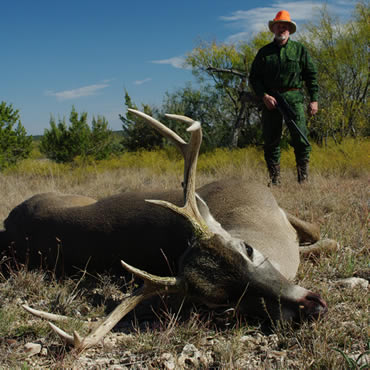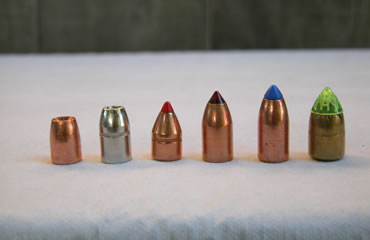Don’t confuse lab potential with real world conditions when hunting with a slug-shooter.
To the best of my knowledge, I’ve never twittered, tweeted, blogged or done anything with an app. I‘ve never been on Facebook and don’t own an iPad, Blackberry or Droid.
Despite my Neanderthal ploddings in the space age world of communications, I somehow manage to be in constant contact with hunters.
For instance, in recent months every Tom, Dick and a remarkable percentage of Harrys in the slug-shooting world have contacted me to determine what load they need to turn their favorite Moss-Rem-Win shotgun into a 200-yard whitetail death ray.
If only it were that easy.
Granted, I probably brought it on myself by publishing a couple of magazine pieces on long range slug shooting, including 250-yard targetry and extremely lucky — if not unethical — 200-yard kills with the newest slugs, scopes and shotguns.
But truthfully, it’s not condescending to say very few of you will find lethal accuracy at 200 yards with a shotgun. In fact, I shouldn’t have.
Hitting a target two football fields away takes an ultra-accurate shotgun, a high-performance slug that fits that gun perfectly, excellent optics, a solid rest and a very experienced shooter on a day when the meteorological conditions cooperate fully. That’s a tough combination to put together.
I hate to be a party pooper, but speaking ballistically and realistically, 150 yards — maybe 170 at the outside — is a far more reasonable and ethical goal than 200. And then only with the right 12-gauge equipment, shooter and situation.
With 20-gauge ammunition, despite published accounts, it’s best to keep it inside 140 yards.
Granted, slugs have and will kill farther out, but beyond the mentioned yardages, the situation becomes more a matter of luck than ballistics, especially if the wind is blowing.
 THE 20-GAUGE STORY
THE 20-GAUGE STORY
The 20 gauge has been getting a lot of love recently, and a bit more respect than it probably deserves.
Granted, the 20 is theoretically more accurate than the 12 gauge because its smaller diameter makes it more aerodynamic, and the fact that its saboted slugs are closer to bore size (0.45-inch diameter in 0.615 bore) than the 12 (0.50 diameter in .072 bore). This makes for thinner sabot sleeves and an easier-to-stabilize projectile.
People also assume lighter recoil with the 20 bore, although those looking for long-range performance must utilize the 3-inch 20, which is a thumper in its own right.
Despite the recent outpouring of public sentiment toward the 20-gauge slug and guns, you have to know the small-bore slug invariably runs out of steam before it finishes the second 100 yards. All 20 gauge slugs do.
I know, I know, ballistics figures extrapolated from ultra-tight, 30-inch pressure barrels (which amp up velocity beyond hunter-achievable speeds) machine fired in climate controlled tunnels show 20-gauge slugs with thundering downrange energy. Virtually all manufacturers go that route, but laboratory equipment doesn’t produce real-world ballistics.
Slugs shoulder-fired from a 22- to 24-inch production barrel are considerably slower and hundreds of foot pounds weaker than those published. Been there and tested that.
The industry has long set 1,000 foot pounds of energy as the minimum threshold to kill a deer. The figure came from the renowned Col. Townsend Whelen, and even though it was probably an off-the-cuff comment in the 1930s and certainly not backed by physics, it has been recorded as gospel.
Modern ballisticians believe 700 to 800 foot pounds is closer to the minimum, and again that’s dependent on a very precise impact area, the construction of the projectile and the angle at which the animal is standing.
It’s a real stretch for any 20-gauge slug to reach that minimum outside 150 yards.
ON TO TEXAS
I had an opportunity to put what I considered to be one of the most effective 20-gauge rigs available to the test last November when I was invited to hunt whitetails with Steve Elmore’s Live Oak Lodge (www.liveoakhuntinglodge.net) outside Eldorado, Texas.
You might have seen Elmore guiding elk or turkey hunters on Outdoor Channel television programming, but Live Oak is a deer hunter’s paradise.
We’re talking Edwards Plateau here, fabled whitetail habitat and genetics that make Live Oak’s leases some of the best open-range big-buck opportunities in Texas. It’s an honor to get invited, and I prepared accordingly.
I chose Lightfield’s new Hybred Mag 20 slug, an ultra-accurate 7⁄8-ounce sabot that hits harder than anything on the market within the effective range of 20-gauge ammunition. Its distinctive red hull, accuracy, unprecedented weight and eye-popping energy set it apart from the rest of the 20-gauge slugs.
The shotgun was an H&R Ultra Slugster bull-barreled single-shot, topped with Burris’ remarkable new Eliminator LaserScope. The fabled ultimate 20-gauge whitetail death ray.
A month before in Wyoming, I’d used the same range-finding Burris Eliminator on a Savage 220F 20-gauge bolt gun and was able to hit a 9-inch gong 12 straight times at 256 yards with Remington AccuTip slugs. If darkness and a dwindling supply of slugs hadn’t intervened, I have no doubt we’d be talking about 300-yard accuracy.
Now, understand the 260-grain AccuTip slug, or any other 20-gauge slug, is well beyond its effective range — in fact, bereft of lethal energy — at 250 yards. But the exercise provided testimony as to the remarkable accuracy of the scope/slug/shotgun combination.
The 385-grain Lightfield Hybred Mag 20, using ballistics derived from a 24-inch production barrel, shoulder-fired, offers 2,470 foot pounds of energy at the muzzle and maintains more than 1,000 at 125 yards. We’re talking a real world thumper.
 HYBRED ACCURACY
HYBRED ACCURACY
The slug’s unique Hybred construction — large, blunt-nosed soft lead slug with an attached plastic wad and extremely thin two-piece sabot — are the basis for its reputation for accuracy. At setback (when the prime detonates the powder) the big, soft slug immediately expands. The sabot halves accommodate the expansion by separating yet remaining attached to the slug, thus filling whatever barrel it is in.
Any other sabot design on the market is a hit-or-miss fit for various barrels, which is why virtually all guns prefer a specific slug.
Not so the Lightfield Hybreds. As testimony, I was able to consistently print 1 1⁄8-inch, 100-yard groups with the H&R/Lightfield/Burris LaserScope combination.
Suspending modesty momentarily, it should be noted that I’m considered a pretty fair hand with a slug gun, having shot virtually every gun and every slug on the market over the last 25 years as a means of gainful employment.
I knew what I had and, given the 140- to 150-yard effective range of the slug, I arrived at Live Oak armed in ultimate terms.
HUNTING AT LIVE OAK
Bucks were virtually everywhere, and Elmore’s crew put me on two of the biggest-racked bucks I’ve ever viewed through a scope, one in the 160-inch range, the other crowding 150.
And I missed them both, bigger than hell, on successive days, from a rock-steady rest, with the ultimate slug shooting rig.
I’d wrangled a coveted invitation to what I consider the ultimate deer-hunting dance, and when the opportunity presented itself, I fell face first into the cake.
But my judgment must be faulted far more than my marksmanship.
One miss was at 190-plus yards, and the other closer to 170. With the stiff 25 to 30 mph prairie winds and a shotgun slug, I might as well have been shooting from a ladder stand on Mars.
Such is the disadvantage of slug shooting. Had I brought my .270, the taxidermist would be finishing the mount as you read this.
WIND: A MAJOR FACTOR
Wind is always going to be a factor in slug shooting, regardless of shotgun or projectile. Shotgun slugs are launched slowly and, being so big, their velocity decays far more quickly than bullets. With a large bearing surface and so much time spent in the air, they are always at the mercy of the wind. Big time.
I assume full responsibility for the failures on Live Oak. I know slugs’ ballistic shortcomings, including their vulnerability in wind, yet allowed myself to be blinded by the perceived inflated performance plateaus.
The wind didn’t relent on the final day and, hoping to salvage something in the host’s eyes, I opted to stay on the ground and rattle antlers in an attempt to draw bucks into closer range.
It wasn’t much of a personal sacrifice, since rattling is by far my favorite means of hunting deer. And rattling in Texas, at the right time of year — given the terrain of the Edwards Plateau and myriad bucks — is an experience like no other.
I had several small bucks answer the horns, but all were young with potential for the future, and I passed. When an 8-point cull buck blundered to within 100 yards in a coulee protected from the wind, I finally connected.
When it was all said and done, Elmore graciously invited me back in the future. But not with a shotgun.
Read Recent Articles:
• Home on the Range: Do bucks really live their lives in one square mile?
• Same County, Different Names: B&C and Buckeye Big Bucks recognize Brian Stephens’ Highland County whitetail as an Ohio record. An even bigger deer holds the No. 1 spot in the BTR.
• Shades of Gray: Sometimes doing the right thing isn’t as easy as it should be.
This article was published in the August 2011 edition of Buckmasters Whitetail Magazine. Subscribe today to have Buckmasters delivered to your home.













